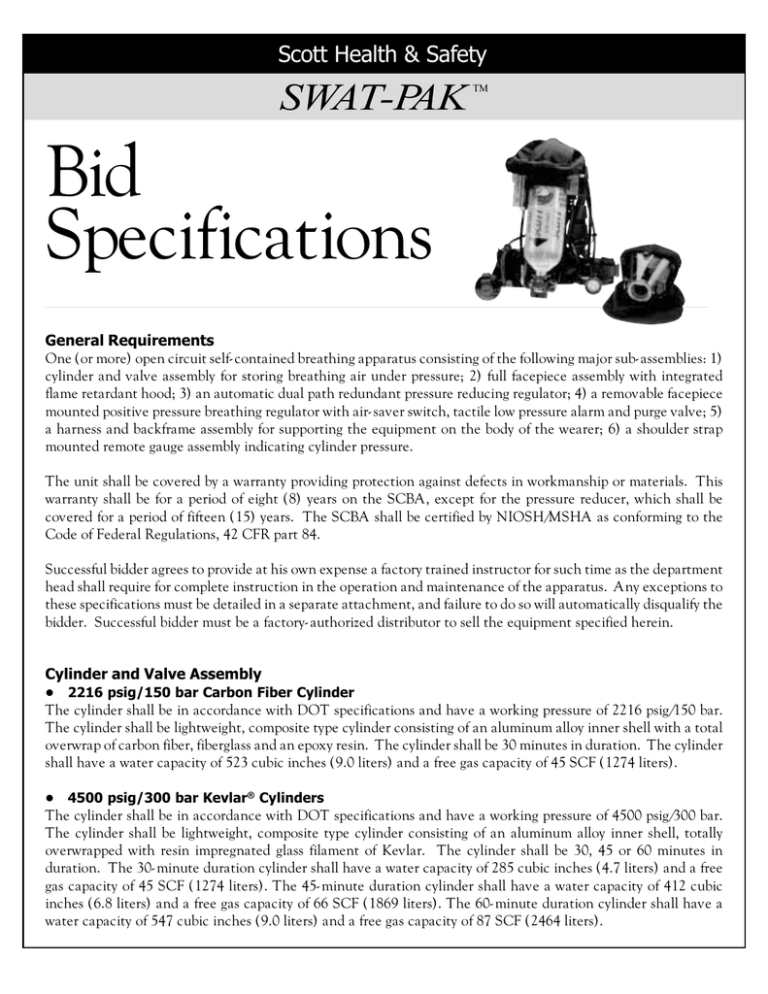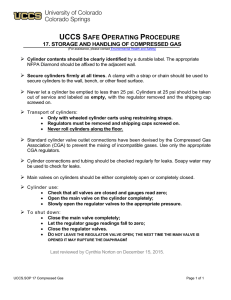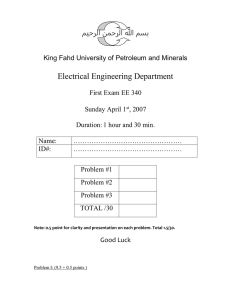
Scott Health & Safety
SWAT-PAK
TM
Bid
Specifications
General Requirements
One (or more) open circuit self-contained breathing apparatus consisting of the following major sub-assemblies: 1)
cylinder and valve assembly for storing breathing air under pressure; 2) full facepiece assembly with integrated
flame retardant hood; 3) an automatic dual path redundant pressure reducing regulator; 4) a removable facepiece
mounted positive pressure breathing regulator with air-saver switch, tactile low pressure alarm and purge valve; 5)
a harness and backframe assembly for supporting the equipment on the body of the wearer; 6) a shoulder strap
mounted remote gauge assembly indicating cylinder pressure.
The unit shall be covered by a warranty providing protection against defects in workmanship or materials. This
warranty shall be for a period of eight (8) years on the SCBA, except for the pressure reducer, which shall be
covered for a period of fifteen (15) years. The SCBA shall be certified by NIOSH/MSHA as conforming to the
Code of Federal Regulations, 42 CFR part 84.
Successful bidder agrees to provide at his own expense a factory trained instructor for such time as the department
head shall require for complete instruction in the operation and maintenance of the apparatus. Any exceptions to
these specifications must be detailed in a separate attachment, and failure to do so will automatically disqualify the
bidder. Successful bidder must be a factory-authorized distributor to sell the equipment specified herein.
Cylinder and Valve Assembly
• 2216 psig/150 bar Carbon Fiber Cylinder
The cylinder shall be in accordance with DOT specifications and have a working pressure of 2216 psig/150 bar.
The cylinder shall be lightweight, composite type cylinder consisting of an aluminum alloy inner shell with a total
overwrap of carbon fiber, fiberglass and an epoxy resin. The cylinder shall be 30 minutes in duration. The cylinder
shall have a water capacity of 523 cubic inches (9.0 liters) and a free gas capacity of 45 SCF (1274 liters).
• 4500 psig/300 bar Kevlar® Cylinders
The cylinder shall be in accordance with DOT specifications and have a working pressure of 4500 psig/300 bar.
The cylinder shall be lightweight, composite type cylinder consisting of an aluminum alloy inner shell, totally
overwrapped with resin impregnated glass filament of Kevlar. The cylinder shall be 30, 45 or 60 minutes in
duration. The 30-minute duration cylinder shall have a water capacity of 285 cubic inches (4.7 liters) and a free
gas capacity of 45 SCF (1274 liters). The 45-minute duration cylinder shall have a water capacity of 412 cubic
inches (6.8 liters) and a free gas capacity of 66 SCF (1869 liters). The 60-minute duration cylinder shall have a
water capacity of 547 cubic inches (9.0 liters) and a free gas capacity of 87 SCF (2464 liters).
• 4500 psig/300 bar Carbon Cylinders
The cylinder shall be in accordance with DOT specifications and have a working pressure of 4500 psig (300
bar). The cylinder shall be lightweight, composite type cylinder consisting of an aluminum alloy inner shell,
with a total overwrap of carbon fiber, fiberglass and an epoxy resin. The cylinder shall be 30, 45 or 60 minutes
in duration. The 30-minute duration cylinder shall have a water capacity of 283 cubic inches (4.7 liters) and
a free gas capacity of 45 SCF (1274 liters). The 45-minute duration cylinder shall have a water capacity of 418
cubic inches (6.8 liters) and a free gas capacity of 66 SCF (1869 liters). The 60-minute duration cylinder shall
have a water capacity of 550 cubic inches (9.0 liters) and a free gas capacity of 87 SCF (2464 liters).
General Cylinder Requirements
The cylinder threads shall be straight with an O-ring or quad ring gasket type seal. The cylinder valve shall be
a “fail open” type constructed of forged aluminum and designed such that no stem packing or packing gland
nuts are required. It shall contain an upper and lower seat such that the pressure will seal the stem on the
upper seat, thus preventing leakage past the stem. No adjustment shall be necessary during the life of the
valve. The cylinder valve outlet shall be a modification of the Compressed Gas Association (CGA) standard
threaded connection number 346 for breathing air.
The valve shall be constructed such that damage will not occur if the coupling is over-torqued by hand. Each
cylinder valve shall consist of the following: 1) a hand activated valve mechanism with a spring loaded positive
action ratchet type safety lock and lock-out release for selecting “lock-open service” or “non-lock open service”; 2) an upstream frangible disc safety relief device; 3) a dual reading pressure gauge indicating cylinder
pressure at all times; 4) an elastomeric bumper; 5) an angled outlet. Each cylinder and valve assembly shall be
equipped with a hanger bracket for positive attachment of the assembly to the backframe.
Facepiece Assembly
The full facepiece assembly shall fit persons of varying facial shapes and sizes with minimal visual interference.
It shall be available in three color-coded sizes and maintain NIOSH/MSHA certification of the apparatus
regardless of the size used. The color coded face seal shall be constructed of a blend of natural rubber/EPDM
and be secured to the lens by a U-shaped channel frame that is retained to the lens using five fastener assemblies, four of which also serve as attachment points for the head harness. The lens shall be a single, replaceable
modified cone configuration constructed of nonshatter type polycarbonate material and be designed to meet
the impact and penetration requirements of a faceshield as specified in ANSI Z87.1 paragraph 5.2.8.2 shall
have a silicone based coating to resist abrasion, chemical attack and meet the requirements of NFPA 1981,
1997 edition for lens abrasion. The lens shall be permanently coated to resist fogging.
The facepiece shall have a large diameter inlet serving as the female half of a quarter (1/4) turn coupling which
mates with the positive pressure breathing regulator or adapter for connecting air purifying canisters and cartridges. Multi-directional voicemitters shall be lens mounted on both sides of the facepiece lens and ducted
directly into an integral silicone nosecup to enhance voice transmission. The voicemitters, ducts and nosecup
shall be easily removable without the use of tools.
The head harness shall be a four-point suspension made in the fashion of a net hood to minimize interference
between securing the facepiece and wearing head protection and shall be constructed of Kevlar material. Two
flame resistant elastic straps, attached to the lens in four locations, shall provide adjustment for proper facesealing.
A four-point attachment rubber head harness shall also be available. A flame resistant hood colored black will
attach to the facepiece with snap fasteners and cover the head harness during use.
Pressure Reducer
The pressure reducing regulator shall be mounted on the backframe and coupled to the cylinder valve through
a short length of internally armored high pressure hose with a hand coupling for engagement and sealing with
the cylinder valve outlet. In lieu of a manual by-pass, the pressure-reducing regulator shall include a back-up
reducing valve connected in parallel with the primary pressure reducing valve and an automatic transfer valve
for redundant control. The back-up pressure-reducing valve shall also be the means of activating the lowpressure alarm device in the facepiece mounted regulator. This warning shall denote a switch from the primary
reducing valve to the back-up reducing valve whether from low cylinder supply pressure or malfunction of the
primary reducing valve.
A press-to-test valve shall be included to allow testing of the back-up reducing valve without disassembly of the
pressure-reducing regulator. The pressure-reducing regulator shall have extended temperature range dynamic
O-ring seals composed of fluorosilicone elastomer. The outlet manifold of the pressure reducing regulator shall
have incorporated a reseatable over-pressurization relief valve which shall prevent the attached low pressure
hose and facepiece mounted breathing regulator from being subjected to high pressure. An optional outlet
manifold shall also have a provision for attachment of an airline supply hose for extended duration use while
reserving cylinder supply for egress. The optional outlet manifold shall also contain a second port capable of
being fitted with an auxiliary supply hose to support a second breathing regulator for the purpose of rescue only.
The auxiliary hose shall be located on the primary wearer’s right shoulder terminated in a black anodized
female quick connect fitting which shall be easily connected and disconnected by trained individuals with a
gloved hand or in low light conditions. The coupling shall also be guarded against inadvertent disconnect
during use of the equipment. An optional supply hose consisting of one male quick disconnect and one black
anodized female quick disconnect will be carried in a black pouch of the backframe assembly waist belt. When
operated in this mode, supplying two breathing regulators, the primary wearer’s pressure reducer shall be capable of simultaneously supplying each regulator with flow of at least 200 liters per minute while maintaining
positive pressure in the respective facepieces.
Facepiece Mounted Positive Pressure Regulator
The facepiece mounted positive pressure breathing regulator shall supply and maintain air to the facepiece to
satisfy the needs of the user at a pressure greater than atmospheric by no more than 1.5 inches (38mm) of water
pressure. The breathing regulator shall maintain this positive pressure during flows up to 500 standard liters
per minute. The regulator shall also meet or exceed the dynamic flow requirement of remaining positive while
supplying a minute volume of 160 liters.
The breathing regulator shall have a low pressure hose which shall be threaded through the left shoulder strap
and couple to the pressure reducing regulator mounted on the backframe. The regulator shall have a black
quick connect coupling in line for use with option outlet manifold and accessory hose or removal of the regulator. The quick connect coupling shall be easily connected and disconnected by trained individuals with a
gloved hand or in low light conditions. The coupling shall be guarded against inadvertent disconnect during
use of the equipment. The low-pressure hose shall be equipped with swivel attachments at both ends.
The breathing regulator outlet port shall be configured as a the male half of a quarter (1/4) turn coupling which
mates to the facepiece and shall be equipped with a doughnut shaped gasket which provides seal against the
mating surface of the facepiece. The regulator cover shall be fabricated of flame resistant, high impact plastic.
The breathing regulator shall also have an integral low pressure alarm device, which shall combine an audible
alarm with simultaneous vibration of the facepiece. This alarm device shall indicate either a low cylinder
condition or primary first stage failure. The breathing regulator shall have a demand valve to deliver air to the
users, activated by a diaphragm responsive to respiration. The demand valve shall use an extended temperature range dynamic O-ring seal composed of fluorosilicone elastomer. The diaphragm shall include the system
exhalation valve and shall be constructed of high strength silicone elastomer.
A purge valve shall be situated at the inlet of the breathing regulator and shall be capable of delivering airflow
between 125 and 225 standard liters per minute. The breathing regulator shall be arranged to direct incoming air
over the inner surface of the facepiece lens to assist in defogging. The components of the breathing regulator shall
be constructed of materials which are not vulnerable to corrosion. The flame resistant cover shall contain an air
saver switch and pressure demand bias mechanism. It shall reactivate and supply air only in the positive pressure
mode when the wearer effects a face seal and inhales. The device shall not affect the breathing flow through the
system while in operation.
Harness and Backframe Assembly
A lightweight lumbar support style backframe and harness assembly shall be used to carry the cylinder and valve
assembly and pressure reducing regulator assembly. The backframe shall be a solid one-piece black anodized
aluminum frame that is contoured to follow the shape of the user’s back. The backframe shall include a mounting
for the pressure reducer. This mounting shall contain a slide-type bracket permitting positioning of the pressure
reducer to accommodate connection to the cylinder valve.
The backframe shall include an over-the-counter adjustable tri-slide fixture, a Kevlar strap and double locking
latch assembly to secure 30, 45 or 60 minute cylinders. The backframe shall also accommodate a black shroud
covering the cylinder and pressure-reducing regulator. The shroud will attach to the backframe using snap fasteners. The harness assembly shall consist of a one size black Kevlar strap. The harness shall include a box stitched
construction with no screws or bolts. The harness shall incorporate black anodized parachute-type quick release
buckles and shall include black shoulder and hip pads.
®
A Scott Technologies Company
309 West Crowell Street, Monroe, NC 28112
Telephone: (704) 282-8400 • Facsimile: (704) 282-8423
E-mail: hssales@scottaviation.com • Website: www.scottaviation.com
All Rights Reserved.
Kevlar is a registered trademark of E.I. DuPont de Nemours and Company
H/S 6262 8/00
Printed in USA


